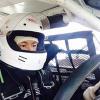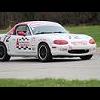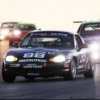I was a front end/suspension tech for 12 years. Did truely. thousands of allignments. Had every car and light truck certification available from ASE, Hunter, Goodyear, etc. Been doing racecar allignments since 1993. As someone who was asked to teach at the Hunter training facility, that is way too much math and theory for me.
Caster is the line formed by the ball joint pivot points. Which we can not get at to measure so we have this complicated system of turning the wheel one way, then the other way, measure camber and subtract. Then to get TRUE caster reading you multiply by 1.444444 and then you have an answer. Or you can use a big expensive machine that does the math for you. Or you can come up with a method that is repeatable and works for you. Just remember to always use the same system. Then only compare your system to your system on identicle cars.
My method:
Set steering wheel and rack to center position, adjust if they don't match
Turn wheel 1/2 turn in one direction, measure camber.
Turn wheel opposite direction 1 turn (1/2 turn the other way). Measure camber and record difference. Wether you turn out, then in or vice versa only tells you if you have positive or negative caster. Since no new car has been built with negative caster since the early 1970's (bias ply tires) our number is always positive.
Now do the other side and compare.
Keep in mind a few things;
different cars have different ratios between the steering wheel angle and the amount of turning accomplished. Even our manual racks have a different ratio than our power racks. If you want to compare car types, you need to use a turn angle rather than a steering wheel angle. But again, if you always do it the same, your numbers will be repeatable and accurate for your own use.
Those big expensive machines actually use a 20* toe reading to make their measurements from. So rack ratio is not important. Measuring that way without pretty sophisticated equipment or measurements is difficult. That is why I use the 1/2 turn method. Turn tables are only accurate if started with no tire bind and from zero. Used that method back in the 80's.
Caster effects camber as the tire turns. Ever seen an old Ford van or 2 wheel drive truck with the wheel turned? It appears that the wheel is going to fall off, there is so much dynamic camber. This is from the HUGE amounts of caster those vehicles used.
Suspension bind has nothing to do with the use of hub stands or not. It is the ability to flex of the rubber bushings. Our ball joints are actual joints, they don't bind. Lots of older cars had rubber bonded ball joints that did bind. But our rubber suspension bushings bind. Imagine tightening the suspension at full droop. Then expecting the bushing to twist as you go into full compression in a corner. That bushing will act as a spring and restrict movement of the suspension(suspension bind). You need to tighten the suspension mounting bolts at ride height, so the bushing has equal resistance in both directions and have enough elasticity to work within the normal range of movement. This is criticle on NC and ND cars. Their 5 link rear suspensions are terrible for bushing bind.
The same theory of using the same method works for toe measurements also. Lots of people use strings at the shop. Measuring from the wheel lip to the string box. The subtracting to get a toe measurment in inches or millimeters based on a 15" wheel. then at the track they use toe plates for a quick check. Toe plates are generally 24" long. Roughly 50% longer than the wheel diameter. Now the angle of toe has not changed, but the method of measurement has change from 15" to 25". So you math with be different. This is hard to explain, so you need a visual aid. Grab a paper and pen.
Draw a horizontal line about 3" long.
Now draw a verticle line at the left tip of the first line about 6 inches long. Should look like a sideways "T"
Now at the other end of the horizontal line draw a verticle line at a 30* angle. Should look something like this "l-/" but connected.
Imagine the horizontal as your wheel spindle. measure up 1" and down 1" to reflect the wheel diameter. Make marks.
Now measure 1.5" each way, this reflects the toe plate (roughly 50% longer). Make marks.
Now measure from the 1" marks to the angled line, subtract and get a toe reading.
Now measure from the 1.5" marks and get a toe reading.
The 1.5 marks are 50% larger!!!!!
The toe angle never changed, but we measure the difference and get an inch/mm number. That can vary wildly based on measurement technique.
You must use the same method of measurement all the time. String boxes are accurate, toe plates are accurate, big fancy laser machines are accurate. But the measurements they supply do not always match each other. FYI, the big fancy machines and the specs published by manufacturers are based on wheel angle converted to inches/mm, based on a 24" wheel/tire diameter.
Hope that helps
dave
Dave Wheeler
Advanced Autosports, the nations most complete Spec Miata shop
Author, Spec Miata Constructors Guide, version 1 and 2.0
Building Championship winning cars since 1995
4 time Central Division Spec Miata Champion car builder 2012-2013-2014-2017
Back to Back June Sprints Spec Miata 1-2 finishes 2016 and 2017
5 time June Sprints winner in Mazda's
6 Time Northern Conference Champion Car Builder
2014 SCCA Majors National point Champion car builder
2014 SCCA Runoffs winner, T4 (Bender)
2014 Central Division Champion, ITS (Wheeler)
2013 Thunderhill 25 hour winning crew chief
2007 June Sprints winner, (GT1, Mohrhauser)
Over 200 race wins and counting.
www.advanced-autosports.com
dave@advanced-autosports.com
608-313-1230




 Sign In
Sign In Create Account
Create Account





 Back to top
Back to top Report
Report
















